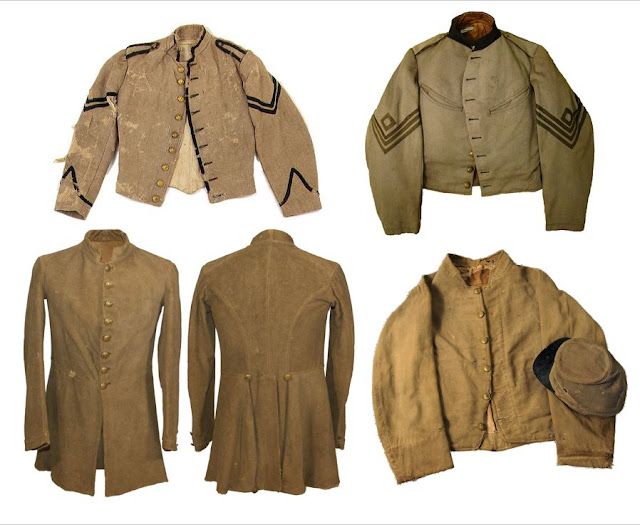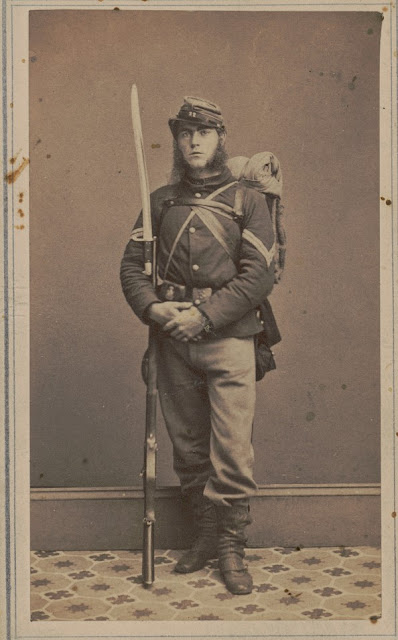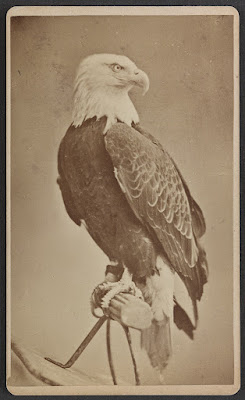Every Man for His Own Pork & Beans: The 29th Wisconsin at Mansfield
In this spicy letter which first saw publication in the May
12, 1864, edition of the Saturday Evening Press from Menasha, Wisconsin,
a soldier correspondent of the 29th Wisconsin with the nom-de-plume Scribus
denounced the folly of how Generals Nathaniel Banks and William Franklin
conducted the Red River campaign by sharing the experience of his regiment at
the Battle of Mansfield.
As part of General Robert Cameron’s Third Division of the 13th
Army Corps, a five-company detachment of the 29th Wisconsin along
with the 46th Indiana (all that was present of the First Brigade) were
brought into line to salvage the collapsing Federal position at Mansfield. It
wasn’t long before Scribus and his comrades in the 29th found
themselves in great peril.
“We who could see what was transpiring
were well aware of the danger, yet we remained until the enemy was so near that
we were completely hemmed in upon the right. Then an overwhelming charge drove
the Second Brigade back, leaving our left quite as much exposed. When the enemy’s
cavalry was within 20 rods upon our left, galloping down across the road and
their balls falling like hail, their infantry upon our right commenced a
galling fire at short range. We saw it was “every man for his own pork and
beans” as the boys sometimes play ball, and the way the 29th
Wisconsin got out of the tall grass and over the ground was a caution to Flora
Temple!”
Our correspondent concluded by giving “a cheer for Grant, McClernand, and General A.J. Smith, and three groans for Banks and Franklin, “the Rebel commissaries!”
Camp of 29th
Wisconsin Volunteers, Grand Ecore, Louisiana
April 15, 1864
As we have had a little smell of
powder lately, I wish to vent my ill nature upon the public at large, there
being prudential motives which prevent its exhibition toward those who have
aroused my temper.
We left Natchitoches on the 6th
and arrived at Pleasant Hills the afternoon of the 7th where we
found the cavalry in an excitement as the Rebels had made a stand in the pine
woods just beyond the place and gobbled up a 100-200 of our men. We went into
camp as usual and all was quiet during the night.
Next morning at an early hour, the
Fourth Division moved on and ours followed while the First Division of the 19th
Army Corps brought up the rear. Five companies of the 29th Wisconsin
(A, C, F, I, and K) were detailed as rear guards for the wagon train leaving
only the 46th Indiana and five companies of our regiment in the
First Brigade. The train belonging to the cavalry division was near the head of
the column while batteries and infantry were scattered promiscuously along in
order to have them protected, I suppose.
As both Generals [Nathaniel] Banks and old
[William] Franklin were along with us, we imagined, there was no great danger
of a fight and yet a feeling of uneasiness was over us because our force was so
much scattered. Our route was through a dense forest of young pines where it
was almost impossible to keep skirmishers deployed as the road was very narrow
and frequently crossed by small ravines. Only one team could, by any
possibility, cross at once and infantry could scarcely pass if by chance a
trace unhitched and a team was obliged to stop.
We passed the place where the cavalry
was surprised the day before and saw the marks of sharp firing upon the trees
around while a dead Reb and the clothing of others who had been removed
indicated that a smart skirmish had taken place. Shortly after this, we heard
firing ahead which was afterwards ascertained to be at a sawmill upon a small
stream some 8-10 miles towards Mansfield from Pleasant Hills. It was between
the 23rd and other regiments of the Fourth Division and a body of
Rebels made of a show of resisting our attempts to advance. The enemy was
driven back and we proceeded a few miles to some fields where we found Franklin’s
headquarters flag and saw indications of going into camp.
 |
| General William B. Franklin |
We soon turned into a field, stacked
arms, and commenced preparations for remaining over night. I learned that the
Fourth Division was 3-4 miles ahead and the cavalry with Nim’s battery was
still further on. Very soon we heard the roar of artillery and in a short time
the order was given to “fall in” and go to the support of the Fourth Division.
We moved off, not at the double quick, but so near it that we made four miles
in less than an hour and the last mile was through the brush as the trains had
blocked up the road. The firing grew heavier as we advanced and soon the
volleys of musketry intermingled with the roar of artillery and we knew there
was work ahead.
To explain a little, it appears that
when the cavalry and advance of the infantry commenced preparations for
encamping, the Rebs opened upon them and, massing their forces for the attack,
succeeded in gobbling up Nim’s battery and driving back the cavalry. The Fourth
Division went in and caused the enemy to fall back for a time; but being in
great force, the Rebels repeated their attempts and finally caused the Fourth
to fall back just as we came up. Our brigade deployed to the right of the road
and the Second Brigade formed in line upon the left.
We were ordered to advance to the edge
of the woods nearly half a mile and having done so, we found an extensive field
with a crooked rail fence running along the borders of the timber. Inside of
the fence was a scattering of dead trees, destitute of bark, and looking very “butternutty.”
There was also a line of Rebs less than 20 rods distance from us, but as they
were dressed in dark clothing, we at first supposed it was a portion of our own
men and for a moment held our fire. But a second look assured us that they were
lawful game and two or three volleys were given them before they got across the
field and out of range.
We soon retired a few rods and stood
in line waiting demonstrations. But a short time elapsed before we could
plainly see a heavy column of the enemy advancing obliquely across the field
for the purpose of flanking us upon the right. Yet we were assured constantly
that “the 19th Corps was upon our right” and there was no danger
when the fact was we had no support; the 19th Corps was at least six
miles back towards Pleasant Hills but coming as fast as circumstances would
permit. But this didn’t help our cause at all, for with 10,000-15,000 men to
oppose our 2,000, they had only to gallop their mounted infantry around and
place themselves in our rear as well as our front.
 |
| General Nathaniel P. Banks |
We who could see what was transpiring
were well aware of the danger, yet we remained until the enemy was so near that
we were completely hemmed in upon the right. Then an overwhelming charge drove
the Second Brigade back, leaving our left quite as much exposed. When the enemy’s
cavalry was within 20 rods upon our left, galloping down across the road and
their balls falling like hail, their infantry upon our right commenced a
galling fire at short range.
For the first time, discovering their close proximity to us
and convincing the brigade command that we were yet unsupported, then he remarked
(it is said) “the men better surrender but he should not be taken alive.” [Lieutenant Colonel Aaron M. Flory commanded the First Brigade] Shortly after he was shot and
supposedly killed. We heard nothing of this, but saw the 46th
Indiana making a movement towards the rear and not in the very best order. We
saw it was “every man for his own pork and beans” as the boys sometimes play
ball, and the way the 29th Wisconsin got out of the tall grass and
over the ground was a caution to Flora Temple!
There is no telling who ran fastest but it is a fact that
everyone who could run gave the Rebs a sight at his coattails, a thing we had
never done before. We found the teams in a perfect jam, completely blocking up
the road and rendering it impossible for the batteries, which were in advance
of them, to get by or through them. Several guns were lost in this way and the
whole train of the cavalry division was left to the Rebels.
Some two or three miles from the field we met our
reinforcements and much of the prejudice against the “Nutmegs” has been removed
by the way they went into the work. The gave the enemy several volleys,
effectually checking them and allowing the rest of the retreat to be made in
good order, also allowing all of the teams back of them time to move back to
Pleasant Hills. It was about 5 p.m. when we opened upon the enemy and nearly
dark when the enemy was checked by the 19th Corps.
By 8 o’clock the morning of April 9th, our force
was all up to Pleasant Hill where we found Colonel Greene with a squad of recruits,
they having come up from Grand Ecore with General [A.J.] Smith and a detachment
of the 16th Army Corps of about 10,000-12,000 men. The brigade of
colored troops commenced skirmishing with the enemy shortly afterwards and about
noon we were moving off towards Grand Ecore with the train while General Smith
remained there to see whether he could handle the enemy better with artillery
and men than Banks and Franklin had by charging with a wagon train! He dressed
the rascals out handsomely before night and then fell back, following us. He
captured 600-700 prisoners that I know of (having seen them) and I have heard
the enemy’s loss estimated as high as 6,000.
Two men of Co. G, Sergeant A.D. Woodman and Private Fritz
Danner and two others of the 46th Indiana came into camp day before
yesterday, having eluded the Rebels by striking back into the woods and toward
the river. They had been reported missing but much to our surprise and
satisfaction, they came safely through though rather thin in flesh having had
no food except dry corn and green peppergrass since the fight.
The total loss in killed, wounded, and missing is 65 men, a liberal loss for only five companies. I would send you a list of casualties if I had time but the mail leaves at 2 o’clock and I fear I cannot complete it. With a cheer for Grant, McClernand, and General A.J. Smith, and three groans for Banks and Franklin, “the Rebel commissaries!”
To learn more about the Battle of Mansfield/Sabine Crossroads, please check out this post:
Worse Than Madness for Us: the 56th Ohio at Sabine Crossroads
Source:
Letter from
Scribus, 29th Wisconsin Volunteer Infantry, Saturday Evening
Press (Menasha, Wisconsin), May 12, 1864, pg. 2











Comments
Post a Comment